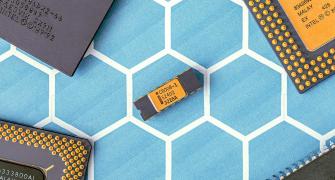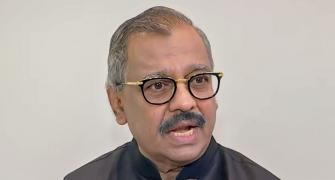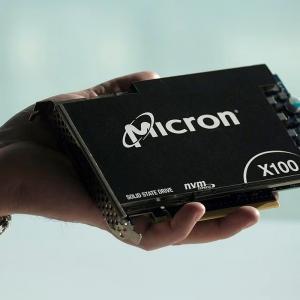The first leg of Micron's semiconductor play in Sanand is crucial for the company to sprint towards India's goal of joining the chip race.

It is easy to miss the freshly painted two-storey building with large glass windows in Sanand Industrial Estate, a smooth 45-minute drive from Ahmedabad, in Gujarat, hidden as it is behind tall neem and Ashok trees.
A blue board says you are on the premises of Micron Technology.
The United States-based memory chip company is the world's fifth-largest in semiconductors.
A few months ago, it acquired 10 acres of land, building and factory from a troubled auto components maker here in Sanand.
The facility is being converted into a pilot assembly, testing, marking and packaging (ATMP) plant.
The ATMP plant is where wafers made from silicon are converted into memory chips.
It always includes a 'cleanroom', which has near-zero dust and vibrations, and where wafers go through 30 to 40 processes, including etching.
The completed chips are sent to a back-end assembly and test facility before they are packaged and sold.
This existing factory, converted into a cleanroom, will roll out the first chip by a global behemoth in India some time between December this year and March next.
In this phase, all processes will be done except testing, which needs a large facility and will be done abroad.
This is the first leg of Micron's semiconductor play in Sanand and is crucial for the company to sprint towards India's goal of joining the chip race, seen by the government as critical to a future of technology-led growth.
In the second leg, even the testing will be done here and only the wafer will be imported. This will be at the mega greenfield plant, starting December 2024.
"The government expects the first made-in-India chip to roll out on December 24," Ashwini Vaishnaw, minister for railways, communications and electronics and information technology, told Business Standard.
The second leg is just a kilometre away from the first. This is where Micron has acquired a substantial 93 acres from the government.
It will have a greenfield ATMP plant that will take 18 months and cost $2 billion. The Gujarat government has given a 50 per cent subsidy on the land's price.
Once ready, it will transform Sanand, the industrial belt synonymous with the automotive industry, into a high-tech semiconductor hub.
It is the first mega project cleared under the central government's $10 billion incentive plan to woo global chip makers.
Sahasra Electronics, with an outsourced semiconductor assembly and test facility in Bhiwadi, Rajasthan, may become the first to roll out a chip, but Micron in Sanand claims many firsts.
At the heart of Micron's twin facilities in Sanand will be the cleanroom, totalling 1 million square feet, among the largest for an ATMP plant in the world.
It has to be free of dust, or the wafers will be rejected by the machines. The requirement is 1,000 small particles per square metre -- a 10th of the norm for an operation theatre.
It will also be one of the most automated plants in the world for an ATMP facility, says Fremont-based Hem Takiar, corporate vice-president, packaging, development and engineering, with Micron.
A 40-year veteran of the industry, Takiar says if the same plant was to be built 13 years ago, it would have required 20,000 to 30,000 technicians, making it unviable. Automation now makes it viable.
Despite the automation, it will still generate substantial employment: 5,000 direct jobs and 15,000 to 20,000 indirect ones, comparable with a passenger car factory.
The two-phase approach worked for Micron in Malaysia. It drastically reduces the time taken to roll out the first chips, which the government is keen to showcase to the world.
If the project had only the greenfield mega plant, it could not have rolled out the first chips before December 2024.
Some of the expensive machines will come from Micron's facility in Penang and be installed in the first leg.
New machines for the mega plant, supplied by only a few global vendors, have a waiting period of more than nine months.
Critics say the project is hyped, as Micron will be merely importing its wafers and doing low-value ATMP processing.
However, Takiar says the value addition could range from 10 per cent to as high as 40 per cent, depending on the product.
The India plant will make flip chips, which is the new technology requiring lithography machines, generally used in a fab plant, as well as the traditional wire-bonded chips.
Experts say making these high-tech chips will infuse India with the expertise to make a fab plant.
Videh Khare, a 2018-batch IAS officer and the mission director for the Gujarat Electronics Mission, says Micron will get 60 MVA of power, with enough redundancy to ensure uninterrupted supply.
The ATMP plant will also require a lot of water, so the state government has assured the company of more than 20 million litres per day of high-quality potable water to process, clean and wash the wafers.
This water will come from the Narmada canal and get processed by the state government. Khare says the water supply can be scaled up to 90 million litres a day, so there is no reason to worry as the Micron factory picks up pace.
Micron plans to recycle 80 to 85 per cent of the water. This is possible because, unlike in the manufacture of wafers, there is limited use of chemicals in the ATMP, except some surfactants and silicon dust that can easily be separated.
Khare says the company has a list of potential vendors that could set shop around the unit.
The plan is to get in four or five of Micron's global vendors globally and some of the machine suppliers to set up service and maintenance facilities nearby.
Talks are in the final stages with a global substrate maker, an existing supplier to Micron.
The state government is also match-making Micron with automation firms, such as with a company in Gujarat that makes robotics for cutting rough diamonds and with those supplying robots to auto companies.
The question remains where the memory chips from Sanand will be sold.
Takiar says for the next two years they will be exported, but later be sold in India to global and Indian companies such as Apple Inc and other technology companies.
But more work remains to be done. Micron needs a bonded warehouse in the factory premises for the expensive machines.
The electronic mission is working with the communications and electronics and information technology ministry and has roped in the customs department to put in place a plan.
Takiar says transportation of the machines from Ahmedabad airport to Sanand on specialised trucks requires a high-quality road with no bumps.
Khare says there are many routes through which the machines can reach Sanand.
That journey is bound to be slow. Micron, meanwhile, is sprinting.


Feature Presentation: Ashish Narsale/Rediff.com









